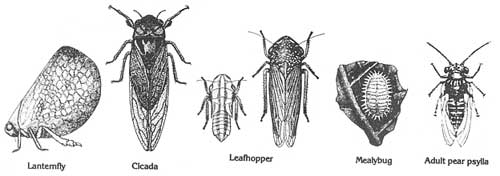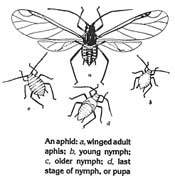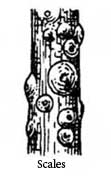Hemiptera (formally Homoptera): Aphids, Cicadas, Scales, Leafhoppers, and others
(from the Greek: hemi = half + ptera = wings)
These hemipterans were formally in the order Homoptera and some 4-H contests may still use that order name. They have piercing mouthparts, 2 pairs of wings, and incomplete metamorphosis. Belonging to different suborders (Auchenorrhyncha and Sternorrhyncha) than true bugs (Heteroptera), the mouthparts of these insects arise further back on the head, near the front legs. The wings, when present, are not like normal Hemiptera wings: they do not have a thickened basal section and a clear tip, and they are usually held “rooflike” over the back instead of flat. All of these insects are plant feeders.

Members of suborder Auchenorrhyncha, consisting of cicadas, treehoppers, froghoppers, and leafhoppers, have 3-segmented tarsi and short, bristlelike antennae. The largest members are the cicadas, which produce the familiar buzzing sound during summer months. Adult cicadas damage twigs and the subterranean nymphs feed on tree roots. Some cicada species have a long life-cycle, with the nymphs taking 17 years to grow.
Members of suborder Sternorrhyncha, consisting of psyllids, whiteflies, aphids, and scale insects, have 1- or 2-segmented tarsi and
 long and threadlike antennae. Aphids, often called “plant lice,” are very common in this suborder. They are soft-bodied and have 2 short tubes projecting from the ends of the abdomens. Aphids are usually wingless (but can be winged) and live in colonies on plants. Aphids are often pests, spreading diseases to crop and garden plants. Hard scales, soft scales, and mealybugs often lose their legs and antennae after the first molt, moving very little after that. Scale insects are very common on trees and shrubs and can be serious pests.
long and threadlike antennae. Aphids, often called “plant lice,” are very common in this suborder. They are soft-bodied and have 2 short tubes projecting from the ends of the abdomens. Aphids are usually wingless (but can be winged) and live in colonies on plants. Aphids are often pests, spreading diseases to crop and garden plants. Hard scales, soft scales, and mealybugs often lose their legs and antennae after the first molt, moving very little after that. Scale insects are very common on trees and shrubs and can be serious pests.

